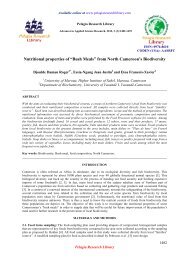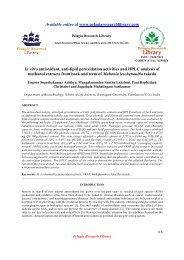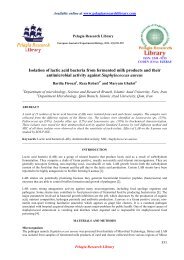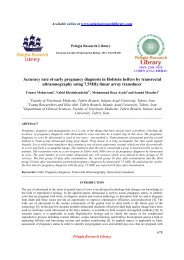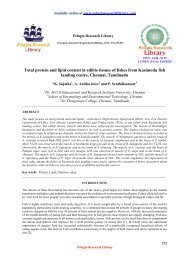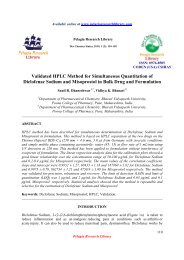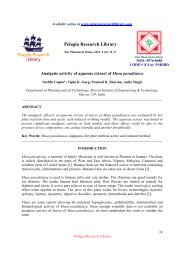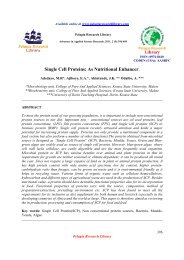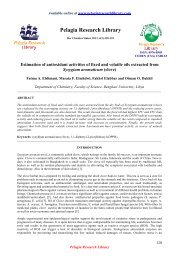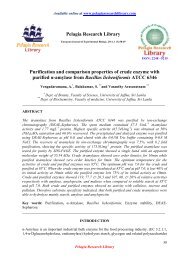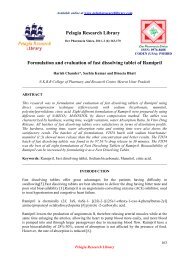Chemical characteristics of low-fat wheyless cream cheese ...
Chemical characteristics of low-fat wheyless cream cheese ...
Chemical characteristics of low-fat wheyless cream cheese ...
Create successful ePaper yourself
Turn your PDF publications into a flip-book with our unique Google optimized e-Paper software.
Khadijeh Poursharif et al Euro. J. Exp. Bio., 2012, 2 (3):690-694<br />
______________________________________________________________________________<br />
2.2 Starter culture<br />
Mesophilic starter culture, contained Lactococcus lactis subsp. Cremoris, Lactococcus lactis subsp. Lactis,<br />
Lactococcus lactis subsp. biovar diacetylactis and Leuconostoc mesenteroides subsp. Cremoris, was obtained from<br />
Chr.Hansen, Denmark.<br />
2.3 Cheese making<br />
Cream <strong>cheese</strong> was made according to the <strong>wheyless</strong> <strong>cream</strong> <strong>cheese</strong> process [10]. Wheyless <strong>cream</strong> <strong>cheese</strong> was<br />
produced from fresh bovine milk. The milk was first standardized t0 the <strong>fat</strong> content <strong>of</strong> about 10-12% for <strong>low</strong> <strong>fat</strong><br />
<strong>cream</strong> <strong>cheese</strong> and 24-28% for high <strong>fat</strong> <strong>cream</strong> <strong>cheese</strong> ,which was kept as control. Then milk was heated at 60 ৹C and<br />
mixed powders skim milk powder(2%w/w), whey protein concentrate(0.5%w/w),locust bean gum (0.01%w/w),<br />
carrageenan,(0.7%w/w),sodium caseinate (5%w/w) and inulin [0%w/w (control or treatment CI,0 ), 8%w/w<br />
(treatment CI,8), 10%w/w (treatment CI,10) and 12%w/w (treatment CI,12). Then was heated at 70 ৹C and homogenized<br />
at about 200 bar and pasteurized at 80 ৹C for 20 min and cooled to 22 ৹C. The pasteurized milk was inoculated with a<br />
mesophilic culture at 22 ৹C and incubated at this temperature until the pH reached a value <strong>of</strong> ~ 4.7. Starter was used<br />
at the rate <strong>of</strong> 1% w/w. After 20 min, rennet was diluted 30 fold with cold water and then added, at concentration <strong>of</strong><br />
4.5 IMCU/kg <strong>of</strong> milk , to milk. The curd was heated, after coagulation, and added salt (0.8w/w). At this point, The<br />
mass was then agitated very gently. The mixture cooked at 40-60 ৹C and homogenized at about 20-70 bar. The<br />
samples were then hot packed at 70 ৹C into 100-g plastic cups and cooled to the storage temperature, 4 ৹C.<br />
2.4 <strong>Chemical</strong> analysis<br />
The <strong>fat</strong> content <strong>of</strong> <strong>cream</strong> <strong>cheese</strong>s was determined by Gerber method [16].The pH <strong>of</strong> <strong>cheese</strong> samples was measured<br />
with a digital pH meter (Mettler Toledo PH meter, model S20-k, Switzerland).Cheese was analyzed for moisture<br />
content by vacuum-oven method [17].Salt content was determined according to the Iran standard methods. All<br />
analyses were conducted after one day <strong>of</strong> storage at 4 ৹C.<br />
2.4 Statistical analysis<br />
Each treatment was performed in three replications. All data are presented as the Mean ± Standard Deviation (SD).<br />
After verifying normality <strong>of</strong> variables, ANOVA analysis fol<strong>low</strong>ed by Duncan post-hoc test for multiple comparisons<br />
were done at significant level <strong>of</strong> 0.05 (p




